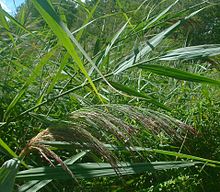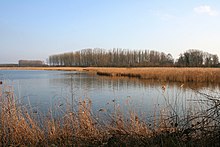Reed bed
This articleneeds additional citations forverification.(December 2012) |


Areedbedorreed bedis a naturalhabitatfound infloodplains,waterlogged depressions and estuaries.Reedbeds are part of asuccessionfrom youngreedscolonising open water or wet ground through a gradation of increasingly dry ground. As reedbeds age, they build up a considerablelitter layerthat eventually rises above the water level and that ultimately provides opportunities in the form of new areas for larger terrestrial plants such asshrubsandtreesto colonise.[1]
Artificial reedbeds are used to remove pollutants fromgreywater,and are also calledconstructed wetlands.[2]
Types[edit]
Reedbeds vary in the species that they can support, depending upon water levels within the wetland system, climate, seasonal variations, and the nutrient status and salinity of the water.Reed swampshave 20 cm or more of surface water during the summer and often have high invertebrate and bird species use.Reed fenshave water levels at or below the surface during the summer and are often more botanically complex. Reeds and similar plants do not generally grow in very acidic water. In these situations, reedbeds are replaced bybogsand vegetation such aspoor fen.
Althoughcommon reedsare characteristic of reedbeds, not all vegetation dominated by this species is characteristic of reedbeds. It also commonly occurs in unmanaged, dampgrasslandand as anunderstoreyin certain types of dampwoodland.
Wildlife[edit]

MostEuropeanreedbeds mainly comprise common reed (Phragmites australis) but also include many other tallmonocotyledonsadapted to growing in wet conditions – other grasses such as reed sweet-grass (Glyceria maxima), Canary reed-grass (Phalaris arundinacea) and small-reed (Calamagrostisspecies), large sedges (species ofCarex,Scirpus,Schoenoplectus,Cladiumand relatedgenera), yellow flag iris (Iris pseudacorus), reed-mace ( "bulrush" –Typhaspecies), water-plantains (Alismaspecies), and flowering rush (Butomus umbellatus). Manydicotyledonsalso occur, such as water mint (Mentha aquatica), gipsywort (Lycopus europaeus), skull-cap (Scutellariaspecies), touch-me-not balsam (Impatiens noli-tangere), brooklime (Veronica beccabunga) and water forget-me-nots (Myosotisspecies).
Many animals are adapted to living in and around reedbeds. These include mammals such asEurasian otter,European beaver,water vole,Eurasian harvest mouseandwater shrew,and birds such asgreat bittern,purple heron,European spoonbill,water rail(and otherrails),purple gallinule,marsh harrier,variouswarblers(reed warbler,sedge warbleretc.),bearded reedlingandreed bunting.
Uses[edit]
Constructed wetlands[edit]
Constructed wetlands are artificial swamps (sometimes calledreed fields) using reed or other marshland plants to form part of small-scalesewagetreatment systems.Watertrickling through the reedbed is cleaned bymicroorganismsliving on the root system and in the litter. These organisms utilize the sewage for growthnutrients,resulting in a cleaneffluent.The process is very similar to aerobic conventional sewage treatment, as the same organisms are used, except that conventional treatment systems require artificial aeration.
Treatment ponds[edit]

Treatment ponds are small versions of constructed wetlands which uses reedbeds or other marshland plants to form an even smallerwater treatment system.Similar to constructed wetlands, water trickling through the reedbed is cleaned bymicroorganismsliving on the root system and in the litter. Treatment ponds are used for the water treatment of a single house or a small neighbourhood.
Gallery[edit]
-
Reedbed ofPhragmites australisandCarex acutiformis
-
Reedbed ofPhragmites australisandTypha latifolia
-
Reedbed ofMiscanthus
-
Reedbed ofArundo donax




